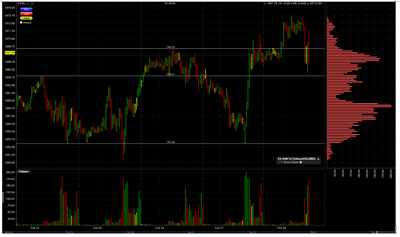Robert Sinn uses a recent trade to illustrate why moving stop levels to allow losing trades more room to run may not cost you every time, but it can—and likely will—catch up with repeat offenders.
On Tuesday, I Tweeted about a few trades on Twitter, and in one particular E-mini futures trade, I was stopped for a two-point loss. A fellow trader asked me, “Why would you set stops so tight?”
Well, first of all, that was my plan, and what might work for you and your account/position size is likely to not fit for someone else. Too often (particularly on StockTwits/Twitter), people personalize everything and forget that everyone is in their own unique situation and has their own individual plan.
On this particular ES trade, my plan was to buy near the 1368.50 support level (my entry was below this level at 67.50) and exit near the 71 area. I was targeting a roughly three-point profit, therefore, I couldn’t really risk more than two points without placing myself in an unfavorable risk/reward proposition (low expected value).
The result of the trade (a two-point loss) is inconsequential. Remember, it is always about planning your trade and trading your plan. Too often, market participants have a tendency to view the market’s movements as being clear in hindsight and find themselves using hindsight bias. Dr. Brett Steenbarger can help us to remember this tendency:
“In retrospect, however, traders will look back on market outcomes and selectively pick out the evidence that would have predicted the market’s movements. They minimize the ambiguity that occurred at the time and convince themselves that they knew all along what the market was going to do.”
The trader then informed me that “I would have stayed in more so ie, lower stop. Look at the pop u could have gotten.” Once again, this person is using a combination of confirmation and hindsight bias with the above comment. I was focused on two key short-term support levels: 68.50 and 64.
The trade plan was to enter in the zone of support/resistance between 66.50 and 68.50, targeting the 71 area. If 65.50 was lost, I figured that 64 would likely be touched. If I was stopped at 65.50—as it turned out I was—I could always get back in after the market had cycled lower.
Sometimes the market will stop on a dime or will move back higher so quickly that one is not able to re-enter in time. Such is the risk we take as traders, but risk management remains paramount above all else. Therefore, in my mind, it was necessary to risk being stopped out at or near the lows of the session before a sharp turnaround higher.
The subsequent market movement confirmed the trader’s previous bias, and in hindsight, he was “correct” in his willingness to “lower his stop.” However, this notion of lowering/moving stop losses is extremely dangerous.
Sure, in the current extremely forgiving market environment, some have been able to get away with lowering sell stops and repeatedly adding to long positions on pullbacks. However, make no mistake: you will be severely punished if you continue to believe that such imprudent risk management/trading strategies will work time and time again.
While such a strategy may work ten or even 20 times in a row in a highly forgiving (to longs) bull trend, it will almost certainly lead to much larger losses over the longer term, which will wipe out any short-term gains.
For market participants who are interested in the longevity of their careers, it is mandatory to stay disciplined and remain focused on the bigger long-term risk-management picture during times of unusually forgiving, less-volatile, uptrending markets.
See related: Biases Traders Don’t Know They Have
By Robert Sinn of RobertSinn.com






















